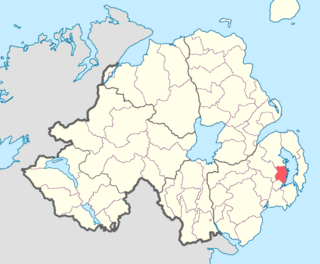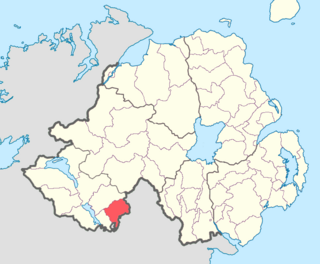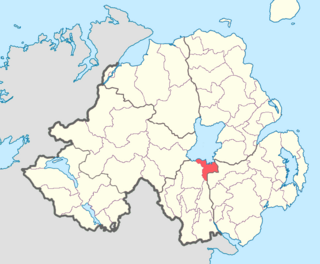Related Research Articles

Fingal is a county in Ireland. It is in the province of Leinster and is part of the Eastern and Midland Region. It is one of three successor counties to County Dublin, which was disestablished for administrative purposes in 1994. Its name is derived from the medieval territory of Scandinavian foreigners that settled in the area. Fingal County Council is the local authority for the county. In 2022 the population of the county was 329,000, making it the second most populated council in Dublin and the third most populous county in the state.
North Dublin, a division of County Dublin, is a former parliamentary constituency which returned one Member of Parliament (MP) to the House of Commons of the United Kingdom from 1885 until 1922. From 1918 to 1921, it was also used as a constituency for Dáil Éireann. From the dissolution of 1922, the area was not represented in the UK Parliament.

Dufferin is a historic barony in County Down, Northern Ireland. It is on the southern half of the west shore of Strangford Lough, and is bordered by three other baronies: Castlereagh Lower to the north; Castlereagh Upper to the west; and Lecale Lower to the south.
Bantry is a barony in the west of County Cork in Ireland. Patrick Weston Joyce said the name Beanntraí means "descendants of Beann [Ban]", a son of Conchobar mac Nessa; similarly for the Wexford barony of Bantry. The barony borders the top end the southern shore of Bantry Bay. On the opposite shore is the barony of Bear. It is also bordered by Carbery West, and Muskerry West to the northeast. To the north is County Kerry.
Barretts is a barony in northwest County Cork in Ireland. The name is derived from the Old English Barrett family.

Cary is a historic barony in County Antrim, Northern Ireland. To its north is the north-Antrim coast, and it is bordered by three other baronies: Dunluce Lower to the west; Dunluce Upper to the south; and Glenarm Lower to the south-east. The Giant's Causeway is situated on the north coast of Cary. Dunineny Castle lies in the civil parish of Ramoan within this barony.

Belfast Upper is a barony in County Antrim, Northern Ireland. To its east lies the barony of Belfast and Belfast Lough, and it is bordered by five other baronies: Belfast Lower to the north-east; Antrim Upper to the north-west; Massereene Lower to the west; Massereene Upper to the south-west; and Castlereagh Upper to the south. The Forth River flows through both Belfast Upper and Lower. The most prominent hills in the barony are Black Hill and Lyle's Hill.

Massereene Lower is a barony in County Antrim, Northern Ireland. To its west lies Lough Neagh, and it is bordered by four other baronies: Massereene Upper to the south; Belfast Upper to the east; Antrim Upper to the north; and Toome Upper to the north-west.

Toome Lower is a barony in County Antrim, Northern Ireland. It is bordered by four other baronies: Toome Upper to the south; Antrim Lower to the east; Kilconway to the north; and Loughinsholin to the west. Toome Lower also formed part of the medieval territories known as the Route and Clandeboye.

Clankelly is a barony in County Fermanagh, Northern Ireland. It is the only barony in County Fermanagh not connected to Lough Erne. It is bordered by two other baronies in Northern Ireland: Coole to the south-west; and Magherastephana to the north-west. It also borders two baronies in the Republic of Ireland: Monaghan to the north-east; and Dartree to the south-east.
The barony of Castleknock is one of the baronies of Ireland. Originally part of the Lordship of Meath, it was then constituted as part of the historic County Dublin. Today, it lies in the modern county of Fingal, Ireland. The barony was originally also a feudal title, which became one of the subsidiary titles of the Viscounts Gormanston.

Omagh West is a barony in County Tyrone, Northern Ireland. It is bordered by three other baronies in Northern Ireland: Strabane Lower to the north-east; Omagh East to the east; and Lurg to the south. It also borders two baronies in County Donegal in the Republic of Ireland: Tirhugh to the south-west; and Raphoe South to the north-west.

Banagh is a historic barony in County Donegal in Ireland. Patrick Weston Joyce said the name Banagh came from Enna Bogaine, son of Conall Gulban, son of Niall of the Nine Hostages. It was created along with Boylagh when the former barony of Boylagh and Banagh was split in 1791 by an Act of the Parliament of Ireland.

Boylagh is a historic barony in County Donegal in Ireland. Patrick Weston Joyce said the name Boylagh comes from the territory of the O'Boyles. It was created along with Banagh when the former barony of Boylagh and Banagh was split in 1791 by an Act of the Parliament of Ireland.

Oneilland East is a barony in the north-east of County Armagh, Northern Ireland. It is also called Clanbrasil. It lies in the north-east corner of the county, on the south-eastern shore of Lough Neagh and the boundary with County Down. Oneilland East is bordered by three other baronies: Oneilland West to the west; Iveagh Lower to the east; and Orior Lower to the south.
Balrothery West is one of the baronies of Ireland. Originally part of the Lordship of Meath, it was then constituted as part of the old county of Dublin. Today, it lies in the modern county of Fingal.
Dublin is one of the baronies of Ireland, an historical geographical unit of land. Its chief town is Donnybrook. It was created by the 1840 Acts from lands that were previously liberties in the county of the City of Dublin. Its name and area were confirmed by the Dublin Baronies Act 1842.
Nethercross is a feudal title of one of the baronies of Ireland. Originally part of the Lordship of Meath, it was then constituted as part of the County Dublin. Today, is in the modern county of Fingal.
Clonmethan is a townland and a civil parish in the ancient barony of Balrothery West, Fingal in Ireland. It is bordered by the parishes of Palmerstown to the west, Grallagh to the north, Hollywood to the northeast, Westpalstown to the east, Killossery to the southeast, Killsallaghan to the south, and Greenoge, County Meath to the southwest.

Gowran is a barony in the east of County Kilkenny, Ireland. The size of the barony is 430.5 square kilometres (166.2 sq mi). There are 35 civil parishes in Gowran. The chief town today is Gowran. The barony contains the ecclesiastical sites of Kilfane and Duiske Abbey The barony of Gowran is situated in the east of the county between the baronies of Fassadinin to the north, the baronies of Kilkenny, Shillelogher and Knocktopher to the west, and the barony of Ida is to the south. It borders County Carlow to the east. The M9 motorway bisects the barony.
References
- 1 2 "Balrothery East". Placenames Database of Ireland. Dublin: Department of Community, Rural and Gaeltacht Affairs. Retrieved 12 April 2010.
- ↑ Vicissitudes of Families by Sir Bernard Burke, Ulster King of Arms, Longman Green Longman and Roberts, Paternoster Row, London, 1861 (pages 363-364)
- 1 2 Joyce, P.W. (c. 1880). "County Dublin". Philips' Handy Atlas of the Counties of Ireland. London: George Philips & Son. p. 10. Archived from the original on 23 September 2015. Retrieved 13 February 2014.
- ↑ "Lambay Island: townland". Placenames Database of Ireland. Dublin: Department of Community, Rural and Gaeltacht Affairs. Retrieved 12 April 2010.
- ↑ "Balrothery East: towns". Placenames Database of Ireland. Dublin: Department of Community, Rural and Gaeltacht Affairs. Retrieved 12 April 2010.
From "Irish placenames database". logainm.ie (in English and Irish). Department of Community, Rural and Gaeltacht Affairs. Retrieved 23 September 2017.:


